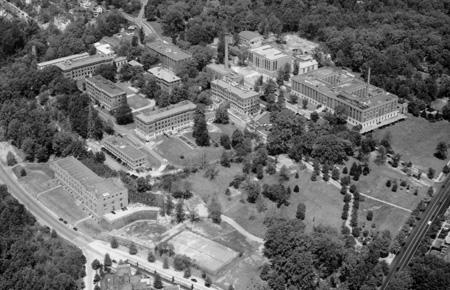
The National Bureau of Standards (circa 1940) at its original location at Connecticut Ave and Van Ness St in Washington, DC.

The National Bureau of Standards (circa 1940) at its original location at Connecticut Ave and Van Ness St in Washington, DC.
Constitution of the United States, Article 1, § 8
The Congress shall have power ... To coin money, regulate the value thereof, and of foreign coin, and fix the standard of weights and measures...Act of 3 March 1901, 31 Stat. 1449 (Public Law 177 - 56 Congress) - An Act to establish the National Bureau of Standards
Be it enacted by the Senate and House of Representatives of the United States of America in Congress assembled, That the Office of Standard Weights and Measures shall hereafter be known as the National Bureau of Standards.Early History*
The Metallurgy Division was founded as part of the National Bureau of Standards in 1913. Early investigations related to the constituents of railroad iron and steel, of heat stress and heat treatment and related problems in the manufacturing process. Other studies included the chemistry of metals and metal alloys, properties of metals at high temperatures, the working of metal in the foundry process, and testing of metals for compliance with Government specifications.
The 2,300,000-pound Emory testing machine for making exhaustion tests of beams, girders, and other large metal structure components.During World War I, the Metallurgy Division conducted armament steel research, investigated the chemical, mechanical and structural properties of aluminum and duralumin (for airplanes), brass (for ammunition), new alloys of steel (for armor), the use and conservation of tin in solder, the use of platinum, rhodium, irridium, and palladium (for catalytic reactions), as well as the new concepts of quantitative composition measurement and control in the manufacturing process.
The experimental 16-inch rolling mill for both hot and cold-rolling of plates, rods, or bars.In the 1920s and 1930s, the Metallurgy Division made advances into understanding corrosion processes in metals, high temperature creep in alloys, the properties of magnesium alloys, the metallurgy of nickel and its alloys, the testing of tool steels, and the mechanical properties of cast iron. In the 1940s, testing methods were developed for use by the steel welding industry, the influence of boron on the hardening of steels, as well as the stabilization of austenitic stainless steels.
The Metallurgy Division has been declared a historical landmark by the American Society of Materials for important developments in precipitation hardening of alloys.
ASM Plaque for the NIST Metallurgy Division.Research Highlights and Publications: 1904 to 1948
Waidner and Burgess, Optical pyrometry (S8 and S11, 1904)
Burgess, Radiation from platinum at high temperatures (S24, 1905; S124, 1909)
Burgess, Melting points of the iron-group elements by a new radiation method (S61, 1907)
Wensel, Roeser, Barbrow and Caldwell, The Waidner-Burgess standard of light (Elec. World, 52, 625, 1908; RP325, 1931)
Burgess, The estimation of the temperature of copper by means of optical pyrometers (S121, 1909)
Waidner and Burgess, On the constancy of the sulphur boiling point (S149, 1911)
Burgess, A micropyrometer (S198, 1913)
Burgess and Crowe, Critical ranges of A2 and A3 of pure iron (S213, 1914)
Waidner and Mueller, Industrial gas calorimetry [First comprehensive study of methods of measuring heating value of gases] (T36, 1914)
Burgess and Foote, Characteristics of radiation pyrometers (S250, 1915)
Waidner, Dickinson et al., Wheatstone bridges for resistance thermometry (S241, 1915; S288, 1917)
Merica, Waltenburg and Scott, The heat treatment of duralumin [First explanation of the phenomenon of age hardening of metals] (S347, 1919)
Merica and Waltenburg, [Pioneer work on the] Malleability and metallography of nickel (T281, 1925)
French and Klopsch, Initial temperature and mass effects in quenching, (T295, 1925; French and Hamill, RP103, 1929)
French and Tucker, Flow in a low-carbon steel at various temperatures [Pioneer work on creep of metals at elevated temperatures] (T296, 1925; Geil and Carwile, RP2329, 1952)
Jordan and Eckman, Gases in metals [Pioneer work on the effects of oxygen and hydrogen on the behavior of metals] (S514, 1925)
Herschman, Air-hardening rivet steels (T358, 1927)
Rawdon, [The prevention of corrosion in duralumin] (Natl. Adv. Comm. Aeron. Tech. Note 284, 1928)
Saeger and Ash, [Practical methods of determining the quality of metals in the foundry] (LC252, 1928; RP399, 1932)
Logan, Soil-corrosion studies [First explanation of the mechanism of corrosion in soils] (RP95, 1929)
French and Digges, Turning with shallow cuts at high speeds [and method for testing high-speed tool steels] (RP120, 1929)
Freeman, Scherer and Rosenberg, Reliability of fusible tin boiler plugs in service [Cause and remedy for their failure in marine boilers] (RP129, 1930; Burgess and Merica, T53, 1914)
Rosenberg and Jordan, Influence of oxide films on the wear of steels (RP708, 1934)
Buzzard and Wilson, Anodic coating of magnesium alloys [for aircraft use] (RP964, 1937)
Krynitsky and Saeger, Elastic properties of cast iron [Optical method for measuring deflection of cast iron bars under pressure] (RP1176, 1939)
Ellinger, Bissell and Williams, [Development of] The tee-bend test to compare the welding quality of steels (RP1444, 1942)
Digges, Reinhart, et al., Influence of boron on some properties of experimental and commercial steels [Substitution of boron for carbon in hardening steels] (RP1815, 1947; RP1938, 1948)
Rosenberg and Darr, Stabilization of austenitic stainless steel [Prevention of corrosion in certain stainless steels] (RP1878, 1948)
NBS Publications
S Scientific Paper
T Technologic Paper
RP Research Paper
LC Letter Circular*Source: Measures for progress: a history of the National Bureau of Standards, by R.C. Cochrane (National Bureau of Standards, U.S. Dept. of Commerce, Washington, 1966).
| |
| Metallurgy Division of MSEL | metallurgy@nist.gov Home | Mission | History | Research Programs | Research Groups | Publications | Personnel | Research Opportunities | Facilities | NIST Staff Only | Search | Outside Links The National Institute of Standards and Technology is an agency of the U.S. Commerce Department |
Last modified: Thursday, 05 April, 2007 by Metallurgy Webmeister